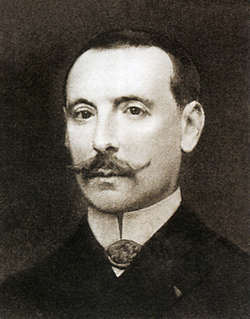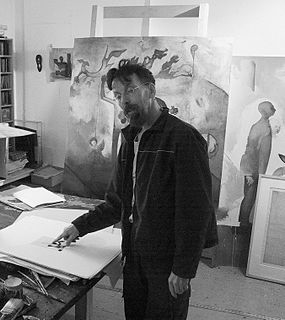
Pierre Mornand (1884-1972 [1] ) was a French writer and bibliophile. [2] He was the editor-in-chief of Le Courrier graphique . [3]

Pierre Mornand (1884-1972 [1] ) was a French writer and bibliophile. [2] He was the editor-in-chief of Le Courrier graphique . [3]
Éditions Gallimard (French: [edisjɔ̃ ɡalimaːʁ]; formerly Éditions de la Nouvelle Revue Française and Librairie Gallimard, is one of the leading French book publishers. In 2003 it and its subsidiaries published 1,418 titles.
Carlos Ginzburg is a conceptual artist and theoretician born in 1946 in La Plata, Argentina. He studied philosophy and social theory.

Dominique Venner was a French historian, journalist and essayist. Venner was a member of the Organisation armée secrète and later became a European nationalist, founding Europe-Action, before withdrawing from politics to focus on a career as a historian. He specialized in military and political history. At the time of his death, he was the editor of the La Nouvelle Revue d'Histoire, a bimonthly history magazine. On 21 May 2013, Venner committed suicide inside the cathedral of Notre Dame de Paris.
Maison Devambez is the name of a fine printer's firm in Paris. It operated under that name from 1873, when a printing business established by the royal engraver Hippolyte Brasseux in 1826 was acquired by Édouard Devambez. At first the firm specialized in heraldic engraving, engraved letterheads and invitations. Devambez clients included the House of Orléans, the House of Bonaparte and the Élysée Palace. Devambez widened the scope of the business to include advertising and publicity, artists’ prints, luxurious limited edition books, and an important art gallery. The House became recognized as one of the foremost fine engravers in Paris, winning numerous medals and honours. With the artist Édouard Chimot as Editor after the First World War, a series of limited edition art books, employing leading French artists, illustrators and affichistes, reached a high point under the imprimatur A l'Enseigne du Masque d'Or – the Sign of the Golden Mask and with PAN in collaboration with Paul Poiret. Édouard's son, André Devambez, became a famous painter and illustrator after receiving the Prix de Rome.
Édouard Chimot was a French artist, illustrator and editor whose career reached its peak in the 1920s in Paris, through the publication of fine quality art-printed books. As artist his own work occupies a characteristic place, but as editor also his role was extremely important in bringing together some of the outstanding talents of that distinctive period in French art and providing the commissions upon which the development of their work in a formal context occurred.

Henri Béraldi was a French bibliophile, publisher and author of books on the Pyrenees and on French printmakers of the 19th century.

Paul Biva was a French painter. His paintings, both Realist, Naturalist in effect, principally represented intricate landscape paintings or elaborate flower settings, much as the work of his older brother, the artist Henri Biva (1848–1929). Paul Biva was a distinguished member of National Horticultural Society of France from 1898 until his untimely death two years later.

Charles-Antoine Jombert was a French bookseller and publisher.

Le Courrier graphique. Revue des arts graphiques was a twentieth century French magazine of the graphic arts published in Paris. It was first published in 1936 and ceased with edition number 118 in 1962. It was produced under the direction of Albert Cymboliste and the editor-in-chief was Pierre Mornand.

Pierre-Paul-Désiré Siraudin was a French playwright and librettist.

Georges Gabriel Thenon, pen name and stage name Rip, was a French chansonnier, draughtsman, librettist and revue creator. Rip wrote successful revues some of which were interpreted inter alia by Mistinguett, Raimu, Arletty, Michel Simon.

Jean-Michel Leniaud is a French historian of art. A specialist of architecture and art of the 19th and 20th centuries, he was director of the École Nationale des Chartes from 2011 to 2016. He is president of the Société des Amis de Notre-Dame de Paris.
Alexis Curvers was a French-speaking Belgian writer. He was married to hellenist Marie Delcourt.

Louis-Pierre Bougie was a Canadian painter and printmaker specialized in engraving and etching. He developed his knowledge of intaglio techniques at Atelier Lacourière-Frélaut in Paris, where he worked for fifteen years, and through travel and study in France, Portugal, Poland, Ireland, Finland, and New York. His work is regularly shown in Canadian, American, and European galleries, and is represented in major public and private collections, notably in Québec and New York. Bougie was considered Québec's foremost engraver for the depth and consistency of his work. He died from pneumonia.

Emile Hemmen was a lyric poet and writer from Luxembourg who lived in Mondorf-les-Bains.
Alan Marshall is a British historian who works in France. He specialised in the history of printing, in particular that of phototypesetting.
François Tuefferd was a French photographer, active from the 1930s to the 1950s. He also ran a darkroom and gallery in Paris, Le Chasseur d'Images, where he printed and exhibited the works of his contemporaries. His best-known imagery features the French circus.
Under the name Pierre Souffron are two brother architects from Périgord, sons of Jean Souffron.
Enrique Marin was a Spanish painter and sculptor.
André Villeboeuf was a French illustrator, painter, watercolorist, printmaker, writer and stage designer.